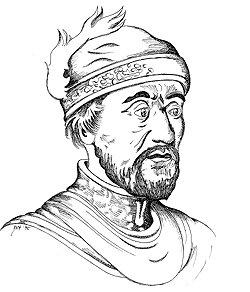 |
 |
|||
|
Commonly
known as the 'Kingmaker,' Richard Neville was the eldest son of his
namesake, Richard Neville, 5th Earl
of Salisbury, by Alice daughter and heiress of Thomas
Montacute, 4th Earl of Salisbury. He is said to have been born at
the maternal family manor of Bisham
in Berkshire on 22nd November 1428. Richardís Earldom of Warwick came from
his marriage, at the age of six, to the sister of the last of the Beauchamp
family who held that title and was, at that time, the richest and most
powerful Earldom in England. His greatest castles were Warwick (Warks),
Cardiff (Glams), Abergavenny (Monmouths) and Barnard (Durham), but he also
favoured Caversham
(Oxon) and others. The
Earl of Salisburyís sister was married to the Royal claimant, the Duke
of York. Her brother and nephew therefore became the greatest
supporters of the Yorkist cause against Margaret of Anjou and the Beauforts,
who swayed the mind of the unworldly Henry VI.
In this capacity, the Earl of Warwick won for the Yorkists the first battle
of the civil wars, at St. Albans, in 1455. After this victory, poor Henry
was obliged to make his enemy 'Captain of Calais', a position which gave
Richard command of the only real standing force in the English dominions. It
also gave him command of a considerable fleet with which, in 1458-9, he did
good service against Spanish fleets in the Channel. In the same year,
Warwick joined his uncle, the Duke of York, in the West of England, was
defeated with him by the Lancastrians at Ludford and fled back to Calais by
way of Guernsey. Thence in 1460 to Ireland and then again to Calais. In the
summer of that year, he was back in Eng≠land and helped to win, for the
Yorkists, the Battle of Northampton. While York and Warwick's father,
Salisbury, went northwards to meet the forces which Queen Margaret had
raised in Scotland and Yorkshire, Warwick remained in London in charge of
Henry, whom he still professed to regard as King. His father's death at the
Battle of Wakefield left Warwick head of the Neville family and added to his
castles the great Yorkshire strongholds of Middleham and Sheriff Hutton.
While York's death - though it left the nominal headship of the party to his
son, the young Earl
of March - gave Warwick undisputed command of the policy of that
party. In
February 1461, the Earl marched out, with poor Henry in his train, to meet
the great Lancastrian army at St. Albans. He was beaten by it and fled to
join March, who in the West had won the Battle of Mortimer's Cross. Edward
IV, as March now claimed to be, entered London as a victor, with Warwick as
his 'Kingmaker' by his side. It was not, however, Warwick but Edward himself
whose generalship was responsible for the final Yorkist victory at Towton on
Palm Sunday 1461. Edward rewarded his great subject with the wardenships of
the Cinque Ports and of the Scottish Marches and the office of Chamberlain;
and Warwick's riches must have been enormous. Warwick
seems to have had some skill in diplomacy and, for the first few years of
the reign, Edward left most things in his hands. But he was anxious that the
King should marry either one of his own daughters or a French princess
chosen by himself. Wherefore Edward's marriage with Elizabeth Woodville and,
still more, the favours which he showered on her relations, soon roused the
jealousy of the Earl. By the year 1468, he seems to have determined to upset
Edward's throne by some means or another. However, as too deep a stream of
blood which he himself had spilt seemed to run between him and the
Lancastrians, he turned to Edward's second brother, the Duke of Clarence. He
married the young duke to his eldest daughter and raised an insurrection
which he allowed Clarence to think would ultimately put him upon the throne.
Edward, a lazy man, was caught napping and allowed Warwick to take him
prisoner; but then Warwick altogether belied his reputation for craft and
reconciled himself to Edward, who, as soon as he was free, drove him from
the Kingdom. There was now but one thing for the Earl to do. He must throw himself at the feet of the haughty Queen Margaret, whom he had slandered and vilified in every possible way, and by her agency raise the flag of King Henry. Louis XI of France, Warwick's steady friend, was able to mediate this astonishing alliance. The Nevilles rose for Warwick and the Western Lancastrians for Henry. Edward was driven from his Kingdom to the Burgundian Court, where his sister was queen, and the Kingmaker landed in England in October 1470. He thus 'remade,' as he had previously unmade, Henry VI as King of England; but Queen Margaret delayed her return. The restored government was profoundly unpopular in London and Clarence, nominally Warwick's ally, became discontented when Warwick married his other daughter to Prince Edward of Lancaster. This situation enabled King Edward to return in March 1471. He caught Warwick in a trap at Barnet, slew him and then advanced to meet and destroy the true Lancastrian army at Tewkesbury. He was laid to rest in his motherís family mausoleum of Bisham Priory (Berks). The manor house at Bisham was lost to the family, although the Earl's grandaughter, Margaret, Countess of Salisbury, did recover it for a while in the early 1500s. Warwick, in spite of his great reputation, was merely a selfish baron of the worst type of the bastard-feudal age of the fifteenth century. His enormous riches bought him a following, which he was able to reward from the goods and lands of his enemies. Edited from CRL Fletcher's 'Historical Portraits' (1909)
|
|||
| © Nash Ford Publishing 2001. All Rights Reserved. | ||||





 Richard
'The Kingmaker' Neville,
Richard
'The Kingmaker' Neville,